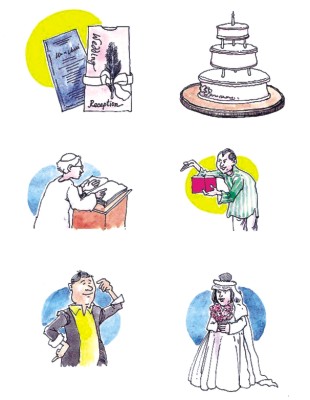|  Learners' Club Learners' Club
Marriage and Wedding Vocabulary
It all starts with a proposal. Traditionally the man goes down on one knee to pop the question.
If he receives a "yes", the couple are engaged. It is customary for the man to buy his fiancee an engagement ring, most commonly a diamond ring. Engagements can last for years, and if neither of the couple breaks off the engagement, the next step is marriage.
Planning the wedding
Most weddings in the UK take the form of either a civil ceremony (conducted at the Registry Office) or a traditional white wedding, held in a church. (There are other ceremonies for different religions.) If the couple chooses a church service, the planning can become quite complex. The church must be booked, the service has to be chosen, flowers arranged and so on. Other arrangements (for both traditional and civil) are to draw up a guest list, send out invitations, book a reception venue (for after the ceremony), choose bridesmaids (the girls who traditionally accompany the bride in the church) and the best man (the bridegroom's friend who accompanies him to the ceremony), buy the wedding dress, arrange a honeymoon (the holiday after the wedding), compile a wedding list (a list of presents that guests can choose to buy the couple) and of course, to select the wedding ring(s).
The big day
The groom and best man arrive at the church first, and then the guests arrive. Last to arrive is the bride, normally dressed in a long white wedding dress with a train (material from the dress that covers the floor behind her), her face covered in a veil, carrying a bouquet of flowers, and accompanied by a couple of bridesmaids in matching dresses. Usually the bride's father walks her down the aisle until they reach the priest / vicar at the altar. The church organ plays the Wedding March, and the guests rise to their feet to watch the procession. Once they reach the altar, the bride stands with the groom, and the service begins. The service lasts for about half an hour, and contains readings (extracts from the Bible) and a couple of hymns (religious songs). The priest always asks if there are any objections to the marriage (someone can speak or forever hold their peace = never have the opportunity again to object), and at the end of the service, the couple exchange rings and are proclaimed "man and wife". At that point, the groom is allowed to kiss his wife. The guests leave and the couple then sign the marriage register. When they come out of the church, the guests often throw confetti (small pieces of coloured paper), and the photographer takes various formal photographs.
Next in the big day is the reception, which is often a formal lunch in a hotel. After lunch there are various speeches. The bride's father normally gives a speech, then the best man gives a speech (which is often a funny speech designed to embarrass the groom), and the bridegroom and / or the bride give a short speech to thank their guests.
Some couples also arrange an evening reception, and hire a disco or band to play music for their friends.
At the end of the day, the happy couple traditionally leave on honeymoon.
Other wedding vocabulary
pre-wedding nerves = when you are nervous before the wedding
wedding bells = the traditional tune that the church bells play as the couple leave the church
wedding vows = the promises that the bride and groom make to each other during the ceremony. Some of these vows could be to love each other "until death do us part" and to love "for richer or poorer, for better or worse, in sickness and in good health".
wedding cake = a traditional cake with three "tiers" eaten at the end of the wedding meal
Copyright
(R) thedailystar.net 2009
|
|

 Learners' Club
Learners' Club